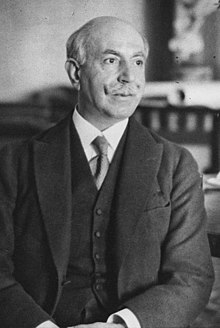Gheorghe Mironescu
Gheorghe Mironescu | |
|---|---|
 | |
| 33rd Prime Minister of Romania | |
| In office June 7, 1930 – June 12, 1930 October 10, 1930 – April 17, 1931 | |
| Monarch | Carol II |
| Preceded by | Iuliu Maniu Iuliu Maniu |
| Succeeded by | Iuliu Maniu Nicolae Iorga |
| Vice President of the Council of Ministers and Minister of the Interior | |
| In office 14 January 1933 – 13 November 1933 | |
| Prime Minister | Alexandru Vaida-Voevod |
| Preceded by | Ion Mihalache |
| Succeeded by | Ion Inculeț |
| Personal details | |
| Born | January 28, 1874 Romania |
| Political party | National Peasants' Party |
Gheorghe G. Mironescu, commonly known as G. G. Mironescu (January 28, 1874 – October 8, 1949), was a Romanian politician, member of the National Peasants' Party (PNȚ), who served as Prime Minister of Romania for two terms.
Biography
Born in
His first stint in government was in Ionescu's cabinet, from December 1921 until the following month, when he served as
In 1930, Carol II of Romania returned incognito to Romania (with a fake passport). On the morning of June 7, 1930, the Government convened Parliament in order to cancel the act of January 4, 1926, through which Carol had renounced the throne.[3] Carol was proclaimed the new King of Romania, replacing his own son Michael. Maniu resigned, and a new PNȚ government was formed, under the leadership of Gheorghe Mironescu, restoring Carol II to the throne on June 8, 1930. The cabinet was welcomed by regent Nicholas with the words:
"You are called on to fulfill King Ferdinand's dream, and you are the most qualified to do it."[4]
The PNȚ subsequently repealed the 1926 laws preventing Carol from inheriting the Crown, and faced a constitutional crisis after
The king's project for a broad-coalition government was not accomplished: Carol offered the appointment to Maniu (who cited health reasons in his refusal, but was in fact disappointed by Carol's ongoing scandalous relationship with Magda Lupescu)[6] and then to General Constantin Prezan (who was rejected by the National Liberal Party). Eventually, the king renounced the project, recognized the mandate of Maniu as majority leader, and conceded to a regular cabinet.[5] Mironescu remained in office as Foreign Minister for the duration of his premiership.[1]
His second time in office, with
In early 1943, during
He died in Bucharest in 1949.[1]
Notes
References
- Keith Hitchins, România, 1866-1947, Humanitas, Bucharest, 1998 (translation of the English-language edition Rumania, 1866-1947, Oxford University Press, USA, 1994)
- Nicolae C. Nicolescu, Enciclopedia șefilor de guvern ai României (1862-2006), Editura Meronia, Bucharest, 2006, ISBN 978-973-783-909-1
- Z. Ornea, Anii treizeci. Extrema dreaptă românească, Ed. Fundaţiei Culturale Române, Bucharest, 1995
- Francisco Veiga, Istoria Gărzii de Fier, 1919-1941: Mistica ultranaționalismului, Humanitas, Bucharest, 1993
- Ioan Scurtu, "Regele a dorit guvern de concentrare", in Magazin Istoric
